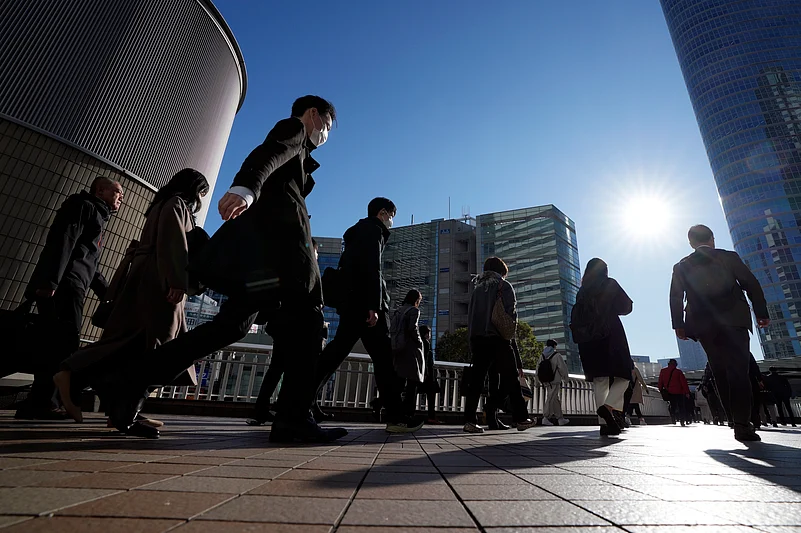While some of the largest global economies falter into recession, the United States continues to steadily progress.
On Thursday, both Japan and the United Kingdom reported that their economies likely experienced a decline in the final three months of 2023. This would mark the second consecutive quarter of such contraction for each country, meeting one common definition of a recession.
However, in the United States, the economy continued to advance in the fourth quarter of last year, marking a sixth consecutive quarter of growth. This exceeded numerous forecasts from the previous year, which had suggested an impending recession due to high interest rates aimed at curbing economic expansion and inflation.
Credit for much of this achievement can be attributed to U.S. households, who have consistently maintained a robust rate of spending despite numerous challenges. Their expenditure constitutes the bulk of the U.S. economy. Government stimulus aided households in navigating the initial phases of the pandemic and a surge in inflation, while recent pay raises are assisting them in coping with elevated prices for essential goods and services.
A report released on Thursday revealed a decrease in the number of U.S. workers filing for unemployment benefits last week. This serves as the most recent indication of an exceptionally robust job market, despite recent attention-grabbing layoff announcements. The sustained strength in this area is expected to bolster the economy.
Naturally, there are still looming risks, and economists caution that a recession remains a possibility. Inflation may experience a resurgence, and concerns regarding substantial borrowing by the U.S. government could unsettle financial markets, potentially leading to increased costs for loans to purchase items such as cars. Additionally, mounting losses associated with commercial real estate could pose significant challenges for the financial system.
However, at present, the forecast for the United States remains more favorable compared to many other big economies. The sentiment on Wall Street is notably upbeat, with the primary gauge of the U.S. stock market, the S&P 500 index, surpassing the 5,000 milestone last week for the first time.
Solita Marcelli, Chief Investment Officer, Americas, at UBS Global Wealth Management, highlights, “First and foremost, it’s important to emphasize that the market’s performance is more a reflection of a thriving economy rather than unwarranted ‘animal spirits’ from investors.”
A couple of weeks ago, when the International Monetary Fund revised its forecast for global growth in 2024 upwards, it highlighted the remarkable resilience of the U.S. economy as a key factor.
Analysts point out that several distinctive features of the U.S. economy have shielded it from the challenges of recession. The U.S. government allocated approximately $5 trillion in pandemic assistance between 2020 and 2021, a significantly higher amount compared to other countries. This substantial support left the majority of households in a considerably improved financial position and sustained consumer spending well into 2023.
The Biden administration further supported the construction of manufacturing plants and infrastructure through additional legislation passed in 2021 and 2022, which continued to have an impact last year. Approximately one quarter of the solid 2.5% growth in the U.S. economy in 2023 stemmed from government spending. However, Republican critics argue that this prolonged spending contributed to increased inflation.
“We had some policies that I do think helped us a lot,” said Diane Swonk, chief economist at KPMG. “But also the structure of our economy is so much different.”
Compared to their counterparts in the UK, Americans have been more shielded from increasing rates, for example, due to the prevalence of long-term, 30-year fixed-rate mortgages among U.S. homeowners. Consequently, the Federal Reserve's swift rate increases over the past two years, which have raised mortgage rates from approximately 3% to about 6.7%, have had minimal impact on many U.S. homeowners.
In contrast, their British counterparts typically hold mortgages that require renewal every two to five years. They have grappled with swiftly escalating mortgage rates as the Bank of England has raised borrowing costs to combat inflation.
Catherine Mann, a member of the Bank of England's interest-rate setting committee, stated on Thursday that the slowdown in the UK economy should be transient. She noted that there are already indications in business surveys suggesting a resurgence in the economy.
“The data we have today is rear-view mirror,” she remarked on the sidelines of an economic conference in Washington. Forward-looking reports “are all looking good.” Similar to the Fed, the Bank of England is contemplating reducing its benchmark rate once it is confident that inflation is under control.
Another advantage for the United States is the recent surge in immigration, which has facilitated businesses in filling job vacancies, potentially expanding their operations, and has resulted in more individuals earning wages and subsequently spending those earnings.

In contrast, Japan is experiencing rapid aging and has witnessed a decline in its population for years, largely due to its limited openness to foreign labor. A shrinking population can significantly impede economic growth.
In Europe, consumer sentiment remains weak as individuals continue to grapple with the repercussions of higher energy prices stemming from the conflict in Ukraine.
Even China, despite outpacing the growth rate of the United States, is encountering significant pressure. Its stock markets have recently been among the world’s worst due to concerns regarding a sluggish economic recovery and challenges within the property sector.
Meanwhile, the U.S. economy confronts its own set of obstacles. Growth is projected to moderate this year as substantial interest rate hikes by the Federal Reserve fully permeate the system.
A report released on Thursday seemingly acknowledged this trend. Retail sales in the United States experienced a more pronounced decline in January compared to economists' expectations.
Certain factors that have supported consumer spending may be diminishing. Student loan repayments have resumed, most consumers have already utilized their pandemic stimulus funds, and credit card balances remain elevated.
Perhaps the most frustrating aspect is that prices for goods at the market remain significantly higher than pre-pandemic levels. Lower inflation indicates that prices are increasing at a slower rate from this point onward, rather than reverting to previous levels.
Dealing with inflation continues to be the primary concern for U.S. consumers, except for those earning more than $150,000, as per a recent survey conducted by Morgan Stanley.
When discussing his company's latest quarterly results, McDonald's CEO Chris Kempczinski noted that he hasn't observed much change in behavior among middle- and upper-income customers. However, he emphasized that “where you see the pressure with the US consumer is that low-income consumer, so call it $45,000 and under. That consumer is pressured.”


























